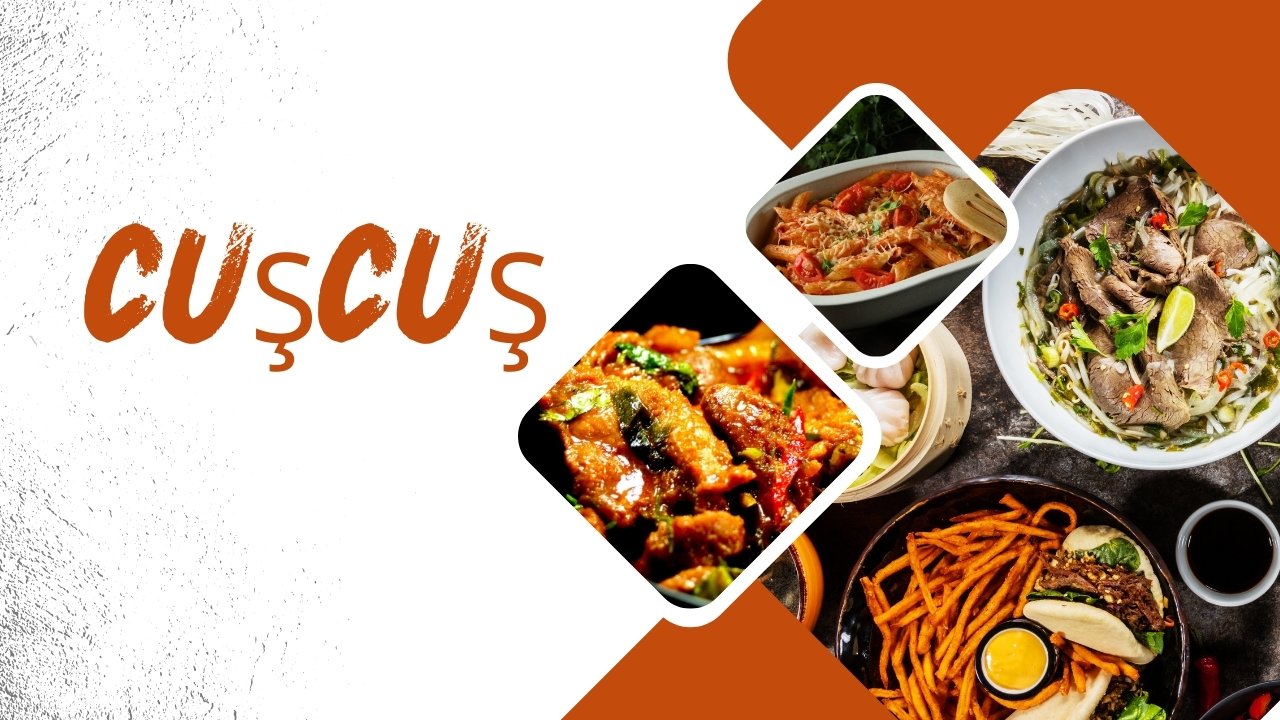Ever wondered about that little grain-like food which seems to be a staple in so many cuisines across the world? Yes, we’re talking about cuşcuş! It’s versatile, it’s nutritious, and it’s delicious. If you’re a foodie, culinary enthusiast, or someone who is health-conscious, then this blog post is just for you. Get ready to take a culinary journey as we explore the delightful world of cuşcuş. We’ll cover its history, types, nutritional benefits, cooking methods, and much more.
What is Cuşcuş?
Cuşcuş, also spelled couscous, is a type of pasta made from semolina wheat. Originating from North Africa, it has traveled far and wide, becoming a beloved ingredient in various cuisines. But what makes cuşcuş so special? Is it the quick cooking time? The incredible versatility? Or its subtle, nutty flavor that pairs well with almost anything?
Brief Definition and Origin
Cuşcuş is tiny granules of durum wheat that are steamed until light and fluffy. Traditionally, it was hand-rolled, but nowadays, machines have taken over this labor-intensive process. Its origins trace back to the Berber tribes of North Africa, where it was a staple long before it gained global popularity.
Cultural Significance in Different Regions
Cuşcuş holds a special place in the culinary traditions of many countries. In Morocco, it’s often served during festive occasions. In Tunisia, it’s a symbol of comfort and hospitality. Even in the Middle East and parts of Europe, cuşcuş has found its way into everyday meals. Its cultural significance goes beyond just being a food item; it’s a part of heritage and tradition.
History and Origin
Historical Background
The history of cuşcuş dates back to the 7th century. It is believed to have originated among the Berber tribes in North Africa. Ancient cooking vessels known as couscoussiers have been found in archaeological sites dating back to this era, serving as evidence of its long-standing historical presence.
Origins in North Africa
Cuşcuş originated in North Africa, specifically in the regions of modern-day Algeria, Morocco, and Tunisia. It was initially made by rolling semolina wheat by hand and steaming it in a pot called a couscoussier. This method ensured that the grains were cooked evenly and retained their light, fluffy texture.
Spread to Other Regions
From North Africa, cuşcuş spread to other parts of the world through trade and migration. It became popular in the Middle East, Mediterranean Europe, and even parts of South America. Each region adopted and adapted cuşcuş to suit local tastes and culinary traditions.
Cultural Importance
Role in Traditional Cuisines
Cuşcuş plays a vital role in traditional cuisines. In Morocco, it’s often served with lamb, vegetables, and a rich, savory broth. Tunisian cuşcuş might include fish, while Algerian versions often feature chickpeas and raisins. Each variation tells a story of regional flavors and preferences.
Festivals and Celebrations Involving Cuşcuş
Cuşcuş is also a dish of celebration. In many cultures, it’s prepared during weddings, religious holidays, and family gatherings. It’s a communal dish, meant to be shared and enjoyed together, which adds to its cultural and social significance.
Types of Cuşcuş
Varieties
One of the fascinating aspects of cuşcuş is its variety. While they all share the common trait of being made from semolina wheat, the differences in size, preparation, and texture make each type unique.
Moroccan Cuşcuş
Moroccan cuşcuş is the most well-known variety. It’s tiny, almost like grains of sand, and cooks very quickly. It’s often used in traditional dishes with meat and vegetables.
Israeli Cuşcuş (Pearl Cuşcuş)
Israeli cuşcuş, also known as pearl cuşcuş, is larger and has a chewy texture. Unlike Moroccan cuşcuş, it’s often toasted before cooking, which gives it a nutty flavor.
Lebanese Cuşcuş
Lebanese cuşcuş is the largest variety. These round granules are almost the size of small peas. They take longer to cook but offer a satisfying bite and are often used in stews and soups.
Differences in Preparation and Texture
The preparation and texture of cuşcuş can vary significantly based on its type. Moroccan cuşcuş is typically steamed and very light, while Israeli cuşcuş is boiled and has a chewiness that holds up well in salads. Lebanese cuşcuş, with its size, is often simmered in broth, taking on a plump, tender texture.
Size and Shape Variations
The size and shape of cuşcuş granules affect how they absorb flavors and combine with other ingredients. Smaller granules mix easily with sauces and vegetables, while larger ones stand out in soups and stews, providing a hearty texture.
Nutritional Benefits
Nutritional Profile
Cuşcuş is not just versatile and tasty; it’s also nutritious. It’s a good source of carbohydrates, providing energy for your daily activities. It also contains protein, fiber, and essential vitamins and minerals like B vitamins, selenium, and magnesium.
Macronutrients and Micronutrients
A single serving of cuşcuş can provide a significant portion of your daily nutrient needs. For example, it offers about 6 grams of protein per cup and is relatively low in fat. It’s also an excellent source of selenium, a powerful antioxidant that helps protect your cells from damage.
Health Benefits
Eating cuşcuş can contribute to a balanced diet. Its high fiber content aids in digestion, while its low-fat content makes it heart-friendly. It’s also versatile enough to fit into various dietary needs, whether you’re looking to gain muscle, lose weight, or maintain a healthy lifestyle.
Comparison with Other Grains
Cuşcuş vs. Quinoa
When it comes to choosing grains, people often wonder how cuşcuş stacks up against trendy alternatives like quinoa. While both are nutritious, they offer different benefits. Quinoa is considered a complete protein, containing all nine essential amino acids, making it an excellent choice for vegetarians and vegans. Cuşcuş, on the other hand, is easier to cook and more versatile in many traditional recipes.
Cuşcuş vs. Rice
Rice is another staple that often gets compared to cuşcuş. Both are quick to prepare and versatile, but they have different textures and nutritional profiles. Cuşcuş has a fluffier texture and is slightly lower in calories compared to white rice. While rice offers more vitamins and minerals, cuşcuş provides a different set of nutrients that can complement a balanced diet.
How to Cook Cuşcuş
Basic Cooking Instructions
Cooking cuşcuş is incredibly simple, making it a favorite for quick and easy meals. Here’s a basic step-by-step guide:
Boil Water or Broth
- Bring a pot of water or broth to a boil. Use a ratio of 1 cup of liquid to 1 cup of cuşcuş.
Add Cuşcuş
- Stir in the cuşcuş, cover the pot, and remove it from the heat.
Steam
- Allow it to steam for about 5 minutes. Fluff with a fork before serving.
Tips for Perfect Cuşcuş
For the best results, here are a few tips:
- Always use a fork to fluff the cuşcuş, which helps separate the granules.
- Adding a bit of olive oil or butter before fluffing can enhance the texture and flavor.
- For an extra layer of flavor, cook cuşcuş in broth instead of water.
Advanced Recipes
Once you’ve mastered the basics, try your hand at some advanced recipes. Traditional Moroccan cuşcuş with lamb and vegetables is a great start. For a modern twist, you can make a cuşcuş salad with roasted vegetables and a tangy vinaigrette. The possibilities are endless!
Popular Cuşcuş Dishes
Traditional Dishes
When it comes to traditional cuşcuş dishes, the options are plentiful. Here are a few that you might want to try:
Moroccan Cuşcuş with Vegetables and Meat
This classic dish features tender pieces of meat, usually lamb or chicken, simmered with aromatic spices and served over a bed of fluffy cuşcuş. Vegetables like carrots, zucchini, and chickpeas add color and nutrition.
Tunisian Cuşcuş with Fish
Tunisian cuşcuş often includes fish, giving it a unique flavor profile. The fish is usually cooked with tomatoes, onions, and a blend of spices, then served over cuşcuş for a hearty and satisfying meal.
Contemporary Recipes
Modern culinary trends have led to a variety of new cuşcuş dishes that are both delicious and innovative.
Cuşcuş Salads
Cuşcuş salads are a fresh and vibrant way to enjoy this versatile grain. Combine cooked cuşcuş with chopped vegetables, herbs, and a light dressing for a nutritious and tasty meal.
Cuşcuş as a Side Dish
Cuşcuş also works well as a simple side dish. Pair it with grilled meats, roasted vegetables, or even a rich stew for a complete and balanced meal.
Cuşcuş in Global Cuisine
Adoption in Different Cuisines
Cuşcuş has found a place in many global cuisines, each adding its unique twist.
Mediterranean Cuisine
In Mediterranean cuisine, cuşcuş is often paired with fresh vegetables, olive oil, and lean proteins. Greek and Italian variations include ingredients like olives, feta cheese, and sun-dried tomatoes.
Middle Eastern Cuisine
In Middle Eastern cuisine, cuşcuş is a staple. It’s often served with lamb, chicken, or beef, and flavored with aromatic spices like cumin, coriander, and cinnamon.
Fusion and Modern Adaptations
The versatility of cuşcuş makes it a popular choice for fusion dishes and modern adaptations.
Cuşcuş in Western Dishes
Western chefs have embraced cuşcuş, incorporating it into everything from pilafs to stuffed peppers. Its quick cooking time and ability to absorb flavors make it a favorite in contemporary kitchens.
Innovative Uses in Gourmet Cooking
Gourmet chefs are also finding creative ways to use cuşcuş. From cuşcuş risottos to cuşcuş crusted meats, the possibilities are endless. Its adaptability makes it a perfect canvas for culinary innovation.
Buying and Storing Cuşcuş
Where to Buy
Cuşcuş is widely available in supermarkets and specialty stores. Look for it in the pasta or international foods aisle. You can also find it in bulk bins at health food stores.
Storage Tips
Proper storage is key to maintaining the freshness and quality of cuşcuş.
Shelf Life
Cuşcuş has a long shelf life if stored correctly. Keep it in an airtight container in a cool, dry place to prevent moisture and pests.
Best Practices for Maintaining Freshness
To keep cuşcuş fresh, store it away from strong odors and direct sunlight. If you buy it in bulk, consider dividing it into smaller portions and sealing them in vacuum bags.
You May Also Like: Enjoy Gelamento: Perfect Dessert to Boost Health & Mood
Conclusion
Cuşcuş is more than just a versatile grain; it’s a culinary treasure with a rich history and cultural significance. From its origins in North Africa to its adoption in global cuisines, cuşcuş has proven to be a staple in many kitchens. It’s nutritious, easy to cook, and incredibly adaptable to various dishes.
Whether you’re a seasoned chef or a home cook, cuşcuş offers endless possibilities. Try incorporating it into your meals and experience the delightful flavors and textures it brings. For more inspiration and recipes, explore our collection of cuşcuş dishes and join our community of food enthusiasts.
FAQs
What is the difference between Moroccan cuşcuş and Israeli cuşcuş?
Moroccan cuşcuş is smaller and cooks quickly, while Israeli cuşcuş, also known as pearl cuşcuş, is larger and has a chewier texture.
Is cuşcuş gluten-free?
No, cuşcuş is made from durum wheat, which contains gluten. If you need a gluten-free option, consider using quinoa or rice.
How do I store leftover cooked cuşcuş?
Store leftover cooked cuşcuş in an airtight container in the refrigerator for up to 3 days. Reheat it in the microwave or on the stove with a bit of water or broth to restore its texture.
Can I freeze cuşcuş?
Yes, you can freeze cooked cuşcuş. Place it in an airtight container or freezer bag and freeze for up to 3 months. Thaw it in the refrigerator before reheating.
What can I serve with cuşcuş?
Cuşcuş pairs well with a variety of dishes, including grilled meats, roasted vegetables, stews, and salads. Its neutral flavor makes it a versatile side dish for many meals.









